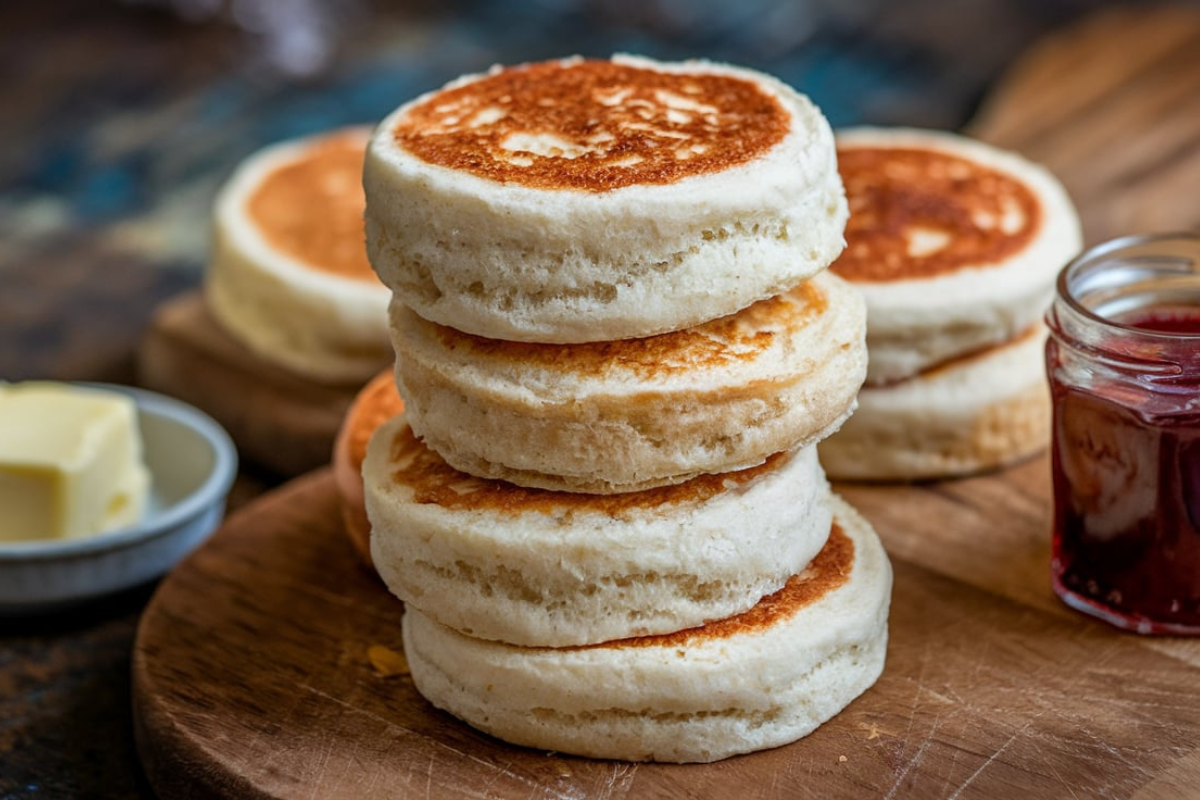English muffins have become a beloved breakfast staple across the globe, cherished for their light, airy texture and their signature nooks and crannies that perfectly hold butter, jam, or even eggs. While many of us enjoy English muffins toasted or served as part of breakfast sandwiches, a common question arises: Are English muffins made with sourdough?
In this detailed guide, we’ll dive deep into the differences between traditional yeast-based English muffins and sourdough English muffins. We will explore what sets sourdough apart from commercially leavened muffins, how sourdough affects flavor and texture, the health benefits of choosing sourdough, and, of course, how to make your own sourdough English muffins at home.
The Origins of English Muffins
While English muffins have become a quintessential part of breakfast in many countries, their history might surprise you. Despite the name, English muffins as we know them today are not originally British. Instead, they were popularized in the United States by Samuel Bath Thomas, an English immigrant, in the late 1800s. Thomas introduced what he called “toaster crumpets” to New York, which later became known as English muffins.
Traditional English Muffins.
Traditional English muffins are typically made with a yeast-based dough, which allows for a quicker rise and a soft, fluffy texture. The muffins are cooked on a griddle rather than baked, giving them their unique outer crust while maintaining a soft, chewy center. Commercial versions often use a combination of enriched dough (containing butter or milk) and a shorter fermentation process, creating a mild, slightly sweet taste.
While these classic English muffins are delicious, the rise in artisanal baking has led to an increased interest in sourdough English muffins, which offer a deeper, more complex flavor and several health benefits.
What Is Sourdough? Understanding the Basics.
Before we answer the central question, Are English muffins made with sourdough? let’s first understand what sourdough actually is.
Sourdough Basics
Sourdough is a naturally fermented dough made using a starter. This starter is a combination of flour and water that captures wild yeast and beneficial bacteria from the environment. Over time, these natural microorganisms feed on the sugars in the flour, producing gases and acids that cause the dough to rise. The fermentation process not only makes sourdough rise but also gives it its characteristic tangy flavor.
Unlike bread made with commercial yeast, sourdough uses a slower fermentation process, which allows for the development of a more complex taste. The acids produced during fermentation also help break down gluten, making sourdough easier to digest for some people.
Sourdough’s Role in Breadmaking
The appeal of sourdough lies in its simplicity and health benefits. The wild yeast and bacteria that naturally occur in the starter act as natural leaveners, eliminating the need for commercially processed yeast. Additionally, the fermentation process develops deeper, more robust flavors, setting sourdough apart from traditional yeast-based breads.
Are English Muffins Made with Sourdough ?

The short answer is no, not all English muffins are made with sourdough. In fact, most commercially available English muffins are made with commercial yeast because it allows for quicker production. However, in recent years, the popularity of sourdough baking has led to a surge of interest in sourdough English muffins, which offer a more distinct, tangy flavor compared to their yeast-based counterparts.
While traditional English muffins rely on commercial yeast for their soft texture and mild flavor, sourdough English muffins take on a whole new character. The longer fermentation process involved in making sourdough creates a chewier texture and a more pronounced taste, offering a rustic alternative to the classic muffin.
What Sets Sourdough Apart?
- Fermentation Time: Sourdough muffins require a longer fermentation process than traditional yeast-based versions, resulting in a tangier, more flavorful product.
- Natural Yeast: Instead of using commercial yeast, sourdough relies on wild yeast found in the environment. This gives sourdough English muffins their distinct flavor and structure.
- Texture: Sourdough muffins often have a chewier, heartier texture than traditional muffins, with more well-defined nooks and crannies.
Key Differences Between Traditional English Muffins and Sourdough English Muffins
Both traditional and sourdough English muffins are delicious, but they offer very different eating experiences. Here’s a breakdown of the key differences between the two:
Flavor Profile
- Traditional English Muffins: Mild, slightly sweet, and soft.
- Sourdough English Muffins: Tangy, with a more complex, slightly sour flavor that comes from natural fermentation.
Texture
- Traditional English Muffins: Light and fluffy, with a soft crumb and delicate nooks and crannies.
- Sourdough English Muffins: Chewier and denser, with more pronounced nooks and crannies that make them perfect for holding toppings like butter or jam.
Health Benefits
- Traditional English Muffins: While they’re still a great source of carbohydrates, traditional muffins don’t offer the same fermentation benefits as sourdough.
- Sourdough English Muffins: The fermentation process involved in making sourdough breaks down gluten, making it easier to digest. Sourdough also has a lower glycemic index, meaning it’s gentler on blood sugar levels.
Why Choose Sourdough ? Health Benefits and Flavor Differences.
Choosing sourdough English muffins over the traditional variety offers several advantages, both in terms of flavor and health. Let’s explore these in detail.
1. Unique, Tangy Flavor
The distinct taste of sourdough comes from the fermentation process, which produces lactic acid and acetic acid. These acids contribute to the tangy, slightly sour flavor that sets sourdough apart from its yeast-based cousins. This flavor is particularly enjoyable in English muffins, where the slightly sour taste pairs beautifully with sweet or savory toppings.
2. Health Benefits of Sourdough
Sourdough isn’t just about flavor; it also offers several health benefits that traditional yeast-based muffins don’t:
- Easier Digestion: The longer fermentation process involved in making sourdough helps break down gluten, which can make the muffins easier to digest for people with gluten sensitivity.
- Lower Glycemic Index: Sourdough bread and muffins tend to have a lower glycemic index than yeast-based breads, meaning they have a slower, more steady impact on blood sugar. This makes them a great option for individuals looking to manage blood sugar levels.
- Increased Nutrient Bioavailability: The fermentation process breaks down phytic acid, an anti-nutrient that can block the absorption of minerals like iron and zinc. This means sourdough can offer better nutrient absorption than traditional bread.
For a closer look at the health benefits of sourdough, read why sourdough discard is healthy, which explores how sourdough can contribute to a more nutritious diet.
How to Make Sourdough English Muffins: Step-by-Step Guide.
If you’re ready to try your hand at making sourdough English muffins at home, you’ll be rewarded with fresh, flavorful muffins that are far superior to store-bought versions. Making sourdough does require patience, but the process is straightforward.
Ingredients:
- 1 cup active sourdough starter
- 3 ½ cups all-purpose or bread flour
- 1 ¼ cups water
- 2 tablespoons sugar
- 1 teaspoon salt
- 2 tablespoons butter (optional)
- Cornmeal for dusting
Instructions:
- Feed Your Sourdough Starter: If you haven’t done so already, feed your sourdough starter and allow it to become bubbly and active. This should take about 4-6 hours, depending on the temperature of your kitchen.
- Mix the Dough: In a large bowl, combine the sourdough starter, water, flour, sugar, and salt. Mix the ingredients until you have a sticky dough. If you’d like a richer flavor, add butter at this stage.
- Ferment the Dough: Cover the bowl with a towel or plastic wrap and let the dough sit at room temperature for 8-12 hours. The dough will ferment and rise during this time. The longer the fermentation, the more pronounced the sourdough flavor will be.
- Shape the Muffins: After the dough has risen, turn it out onto a lightly floured surface. Roll it out to about ½ inch thickness and use a biscuit cutter or glass to cut out muffin rounds. Dust each round with cornmeal.
- Second Rise: Allow the muffin rounds to rest for about an hour on a lightly floured surface. This will give them time to rise a little before cooking.
- Cook the Muffins: Heat a griddle or large skillet over medium heat. Cook the muffins for 5-7 minutes on each side until they’re golden brown and cooked through.
- Cool and Enjoy: Let the muffins cool on a wire rack before slicing them open. Toast them to enhance the flavor and texture!
Creative Variations of Sourdough English Muffins.
One of the great things about making your own sourdough English muffins is the ability to customize the recipe. Here are a few ideas for creative variations:
- Whole Wheat Sourdough English Muffins: Substitute some of the all-purpose flour for whole wheat flour for a denser, more nutrient-dense muffin.
- Add-Ins: Try adding ingredients like grated cheese, herbs, or seeds to the dough for extra flavor.
- Sourdough Discard Muffins: If you have extra sourdough discard, you can use it in this recipe to reduce waste while still making delicious muffins. For more ideas on how to use discard, check out this recipe for sourdough discard crackers.
FAQs About Sourdough English Muffin
1. Can I Use Sourdough Discard in English Muffins?
Yes! Sourdough discard works just as well as an active starter. However, the rise might not be as pronounced, but you’ll still get the tangy flavor that sourdough is known for.
2. Are Sourdough English Muffins Gluten-Free?
No, sourdough English muffins are not gluten-free. However, the fermentation process can reduce the gluten content, making them easier to digest for people with mild gluten sensitivities.
3. How Long Does It Take to Make Sourdough English Muffins?
From feeding the starter to finishing the muffins, it typically takes 12-18 hours, including fermentation time. But the active preparation time is only around 30-40 minutes.
Conclusion
Whether you’re a fan of traditional English muffins or curious about the tangy flavor of sourdough English muffins, there’s no denying that sourdough adds a unique twist to this classic breakfast item. With its rich flavor, chewy texture, and added health benefits, sourdough is an excellent choice for anyone looking to elevate their breakfast experience.
By following this guide, you’ll not only learn how to make delicious sourdough English muffins at home but also discover the many advantages of choosing sourdough over traditional yeast-based breads. Whether you enjoy them with butter, jam, or as part of a breakfast sandwich, sourdough English muffins are sure to become a favorite in your kitchen.

